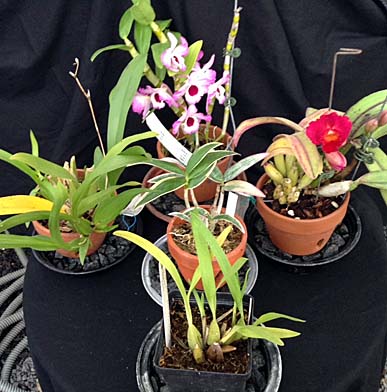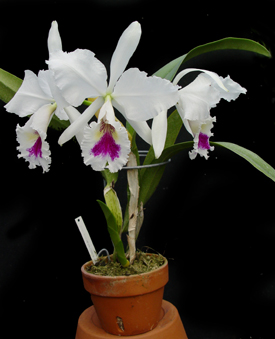H-A-L-T Means TLC for Orchids
By Joe Francis, Fairfax Master Gardener
When it comes to growing orchids, H-A-L-T doesn’t mean stop; it means proceed with the knowledge it takes to grow these beautiful plants successfully. Orchid plants require H-A-L-T to thrive; that is, they depend upon:
- Humidity for the transfer of moisture through the velamen covering of its epiphytic root system
- Air movement to maintain the root system and plant health
- Light for completion of its growth and subsequent flowering
- Temperature to match its inherited genetic growth characteristics
 Humidity
Humidity
A discussion of an orchid’s growing environment begins with humidity, the constant source of moisture to the velamen coating on the epiphytic orchid root system. Total lack of humidity will kill the plant quickly; insufficient amounts of humidity will kill the plant slowly. A delicate kabuki dance takes place between the grower’s control of the watering can and the root system’s ability to absorb moisture and dry out between watering events. This balance is much easier to maintain if the grower places humidity trays filled with water and pebbles beneath the plant to insure that the growing pot sits ABOVE and not IN standing water. Grouping plants in close clusters in their humidity trays will create a humid microclimate.
Air circulation
Air circulation is essential to the drying-out process of the velamen covering on the root system. It insures air movement in and around the leaf surfaces of the plant and prevents fungal infections. It ameliorates the effect of excessive heat in the growing environment, and — in combination with light-misting applications — it quickly controls temperature surges. Air circulation is a 24/7 necessity in orchid culture. It is not uncommon to find the home grower giving short shrift to this essential environmental control. The price is a struggling plant making the slow trek to the compost bin, never having produced a flower and heavily laden with surface fungal growth.

Cattleya orchid
Light is essential for proper growth and flowering. Different orchid genera have different light requirements. The genus Cattleya’s governing cultural factor is light. Without the proper level of light, there will be no flowers. Most hobbyists attempt to grow Cattleyas with too little light; the result is new growth that is very weak. The genus Dendrobium is best grown in high-light conditions and will richly reward the grower who places the plant outside to capture the 14 hours of daylight throughout the late spring, summer and early fall. Bright, dappled light is best; and all summering plants need to be shaded during the high-noon period, when the sun is directly overhead. Outdoor culture requires some protection from direct sunlight, but it is highly beneficial for both growth and flowering.
The genus Phalaenopsis (moth orchid, found in great numbers in the general trade) requires about one-third of Cattleya’s light requirements for growth and flowering. Phalaenopsis orchids are best kept indoors.
Temperature
As the light levels increase in all environments, there is often a concurrent increase in heat. This must be managed to avoid the adverse effects of temperature extremes. Temperature levels bind the three preceding components into a mix that provides for sustained plant growth. Most orchids do well in temperatures ranging between 54 to 84 degrees F. There are notable exceptions: The genus Cymbidium (seasonally available in the mass market) is “cold tolerant” and thrives between 34 and 54 degrees F but tolerates daylight temperatures into the mid-80s. This genus requires cool evening and night temperatures in the fall to set its flower spike buds.
It is prudent to think of all four elements as a harmonious unit in support of your orchid-growing efforts. They are interdependent and contribute equally to the success or failure of those efforts.
Joe Francis is an award-winning orchid growing.